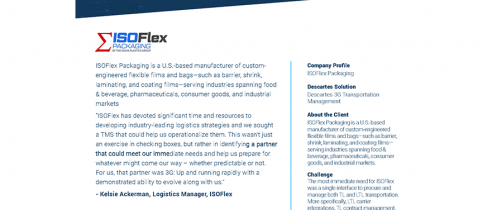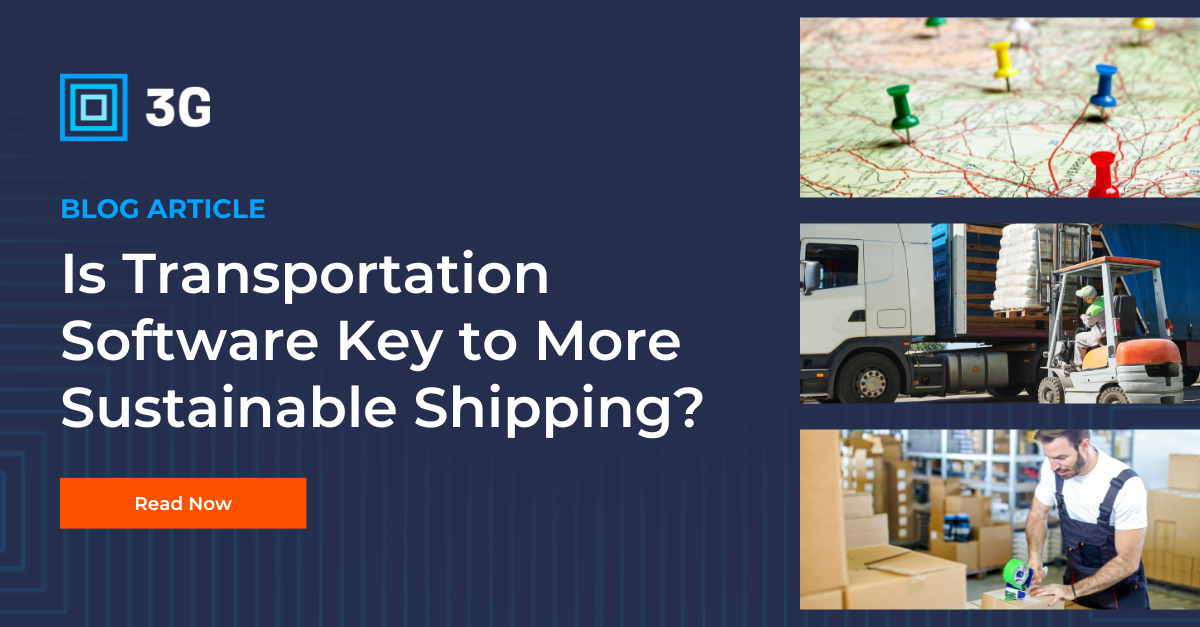As sustainability becomes an increasingly important metric in the supply chain, stakeholders have begun expanding their eco-friendly and conservation efforts beyond just manufacturing practices, impacting freight and parcel shipping as well. The Environmental Protection Agency predicts U.S. freight shipments will be the source of as much as 40% of the nation’s air pollution by 2040, and even exceed growth in greenhouse gas emissions from all other types of transportation, including passenger vehicles.
It’s well documented that transportation software — especially software suites that offer end-to-end management of transportation, shipping, and more — can dramatically improve efficiency and reduce costs. But can it create a pathway to more sustainable shipping?
Why Sustainable Shipping Is So Important
Sustainability encompasses a much more complex system of metrics beyond simply reducing pollution — it involves systems and practices that improve tangible KPIs related to climate change, material waste, and water and air quality, to name just a few areas. What’s more, environmental sustainability is increasingly becoming a viable pathway to improving economic sustainability, a major reversal from previous decades where it cost more to be eco-friendly.
When it comes to the freight shipping industry, leaders are primarily focused on:
- Carbon Emissions Reduction
Carbon emissions — also known as greenhouse gas (GHG) emissions — are recognized as the leading contributor to global warming and resulting climate change. And the burning of fossil fuels — like the kind used for transport throughout the supply chain — is the leading producer of carbon emissions. The International Energy Agency reports that in 2022, international shipping alone accounted for approximately 2% of global energy-related CO2 emissions. Meanwhile, Sinay, a maritime shipping data analytics company, reports that medium-to-heavy trucks used for freight transport account for around 23% of total emissions in the transportation sector.
Carbon reduction is fast becoming the unifying goal of the entire shipping industry, with the ultimate aim of achieving net zero emissions. Strategies like transitioning to cleaner fuels, adopting energy-efficient technologies, and optimizing transportation routes allow stakeholders to make significant strides in mitigating their environmental impact.
Sustainability has even been elevated to a C-Suite concern, especially with the recent move by the Securities and Exchange Commission (SEC) to enhance and standardize climate-related disclosures for investors. These rules require companies, including those in the transportation and shipping sectors, to disclose their greenhouse gas emissions, climate-related risks, and strategies for reducing carbon footprints.
- Circular Economy
The freight shipping industry also plays a central role in waste reduction and laying the foundation for a “circular economy,” which maximizes resource efficiency and minimizes environmental impact to produce virtually zero waste. Waste from damaged products and excess packaging generated by the shipping industry is currently a major barrier to achieving this sustainability goal.
As eco-friendly materials and practices become more easily adoptable, shippers will need to prioritize minimizing packaging, using recyclable and biodegradable materials to promote resource conservation throughout the supply chain.
- UN’s Sustainable Development Goals
As one of the most impactful industries on the planet, improving sustainability in freight shipping is essential for meeting the United Nations’ Sustainable Development Goals (SDGs), a set of 17 interconnected objectives aimed at addressing global challenges like climate change, environmental degradation, and sustainable economic growth. Many industries, including shipping, are aligning their own sustainability efforts with the SDGs to meet specific targets by 2030 in order to build collective momentum and maximize global impact.
How Transportation Software Enables More Sustainable Shipping
There are a lot of ways the freight shipping industry can improve their sustainability profile, but perhaps the single biggest impact would come from improving efficiency, dramatically reducing fuel consumption in the process. Those efficiency gains are exactly what transportation software is designed to offer. By upgrading their technology infrastructure, shippers can benefit from:
Better Route Planning
The most advanced transportation software in the market leverages real-time data analysis and advanced algorithms to automatically optimize truck routes, going beyond static map data and factoring in live traffic conditions, weather, vehicle capacity, and delivery schedules. Optimizing routes far more efficiently than humans are capable of at the high volume and speed of today’s industry allows shippers to significantly cut fuel consumption and reduce emissions, improving both sustainability metrics and overall cost savings.
Load Consolidation and Optimization
Data analysis and algorithmic planning are also useful for analyzing loads and identifying opportunities to maximize available cargo space, enabling users to consolidate their shipments. This process minimizes the number of trucks needed on the road, further reducing fuel consumption and emissions per unit. The combined impact of load consolidation with route optimization can dramatically reduce their carbon footprint over the course of a year.
Real-Time Monitoring
Transportation software can help companies achieve more sustainable shipping practices by enabling stakeholders to monitor fuel consumption, emissions, and other critical sustainability metrics. More importantly, these platforms also provide high-level visibility into operations, helping users adjust their processes in real time to improve efficiency throughout their operation. This enables stakeholders to take a more proactive approach to sustainability, as well as reduce costs.
Predictive Packing
One of the most important elements of sustainable shipping is reduced packaging waste. Transportation software’s data analysis and versatile algorithms can automatically identify the most suitable box(es) for a shipment to perfectly balance shipment protection while reducing waste of space and material. By reducing the number of boxes for a shipment, shippers can transport more in fewer vehicles, cutting fuel consumption.
Enhanced Compliance Tools
In many cases, transportation software can automate compliance measures, ensuring that shipments adhere to company sustainability standards with less chance of oversight or human error. This includes monitoring the use of packaging materials, fuel consumption thresholds, and other metrics, and automatically flagging non-compliances so stakeholders can quickly address issues. This automation not only streamlines compliance processes, but also helps improve transparency and accountability in sustainability practices across the supply chain.
Achieving Sustainable Shipping With the 3G Transportation Suite
To really make an impact on sustainable shipping metrics, stakeholders need a transportation solution that provides end-to-end visibility and control in one platform. That’s where software like the 3G transportation suite comes in. One solution can bridge transportation management and shipping in a unified workflow, helping users achieve maximum efficiency and impact on sustainability goals.
One customer, Green Circle Growers, has already significantly reduced carbon emissions with load optimization. After implementing 3G into their operation, they were able to maintain their volume with 288 fewer loads, generating approximately $520,000 in savings. 3G’s load and route optimization capabilities helped AmerCareRoyal reduce miles driven by almost 20%, saving 200,000 gallons of diesel per month. Annually, this results in 22 million fewer kilograms of CO2 emission, the equivalent of removing 110 trucks from the road. Future builds of 3G’s suite will enable even more in-depth tracking of CO2 emissions. In the future, the platform will offer more advanced and explicit GHG and CO2 tracking and management features to help users achieve carbon reduction goals.
Improving sustainable shipping is no longer a far-off objective — companies need to take action now to contribute to 2030 goals. Transportation software like 3G is an increasingly essential tool in becoming a more eco-friendly company. Schedule a demo to see how it can improve your operation.








